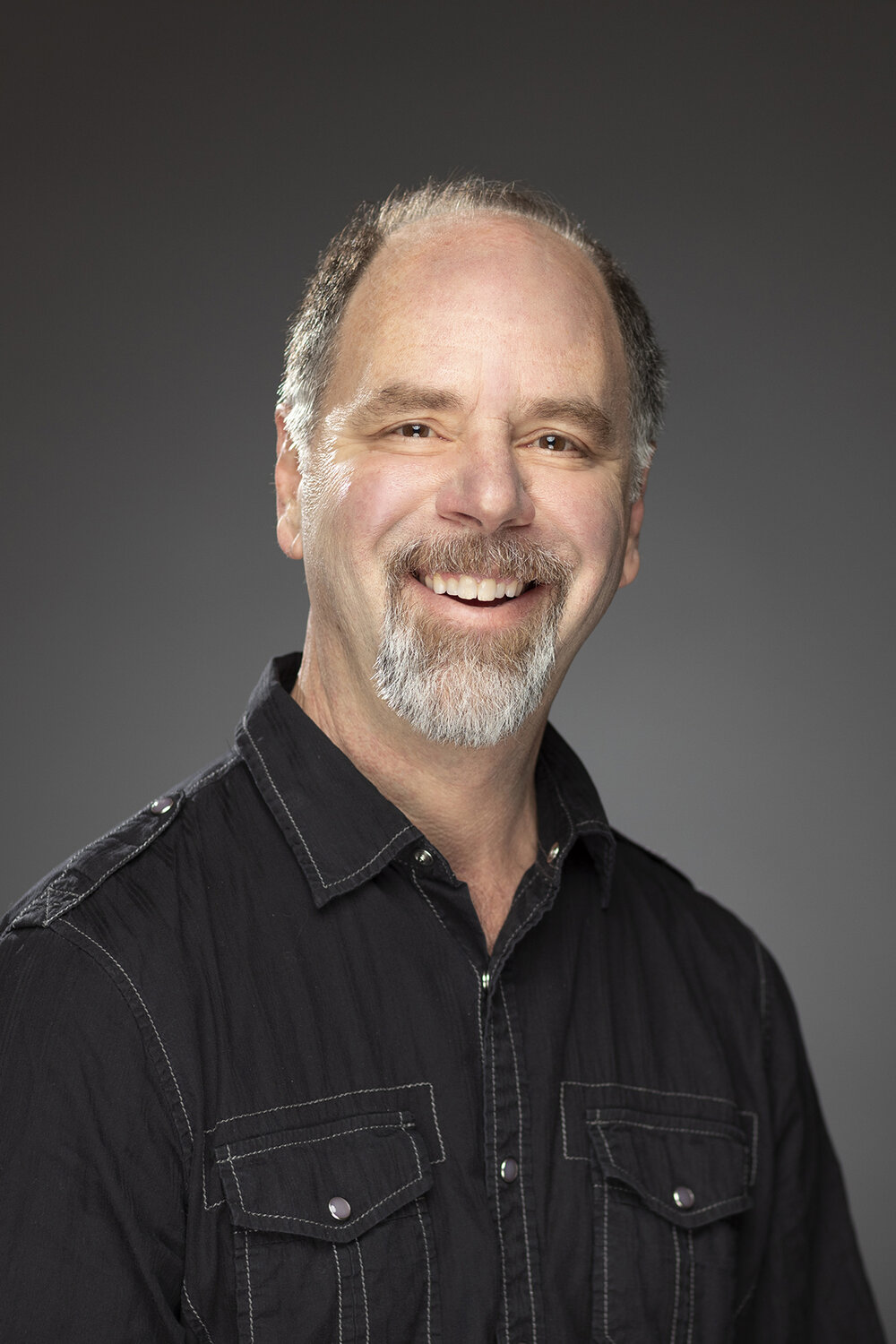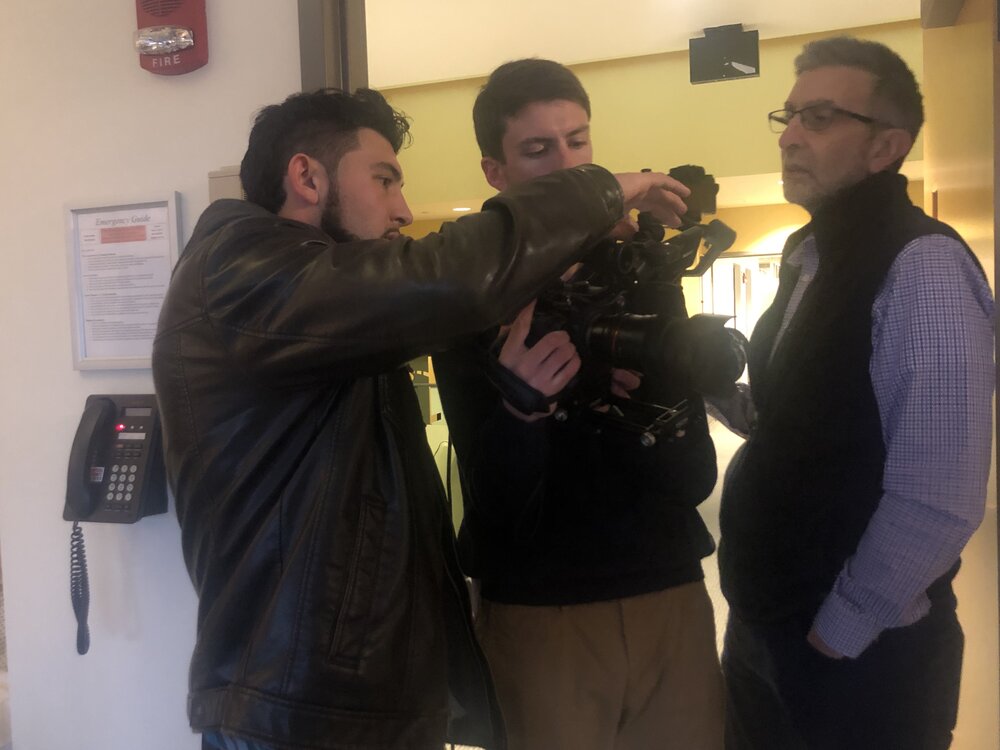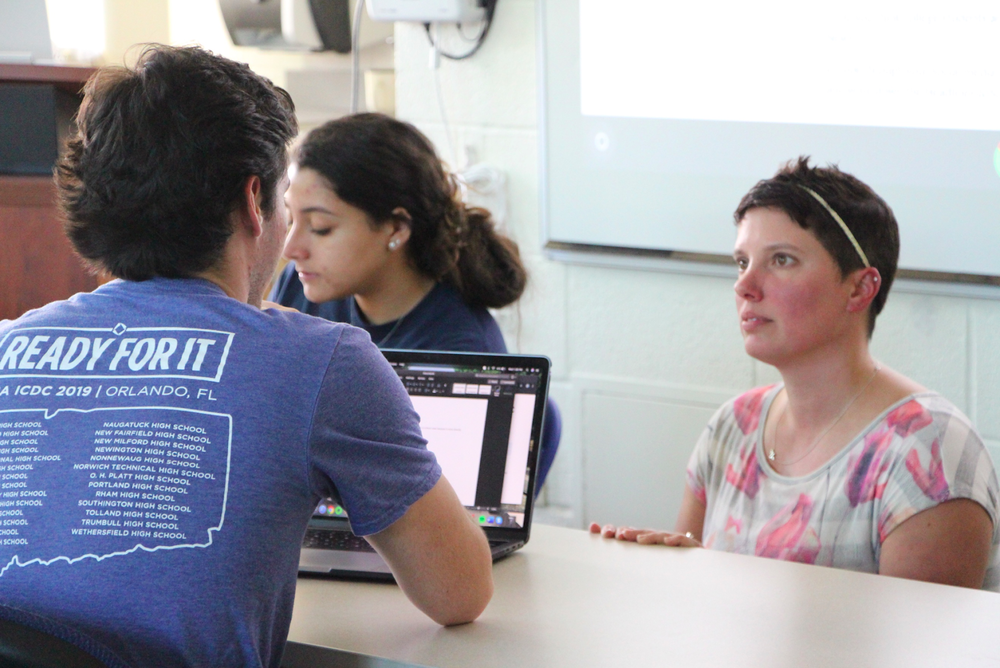By Brent Costantino
The new economy of filmmaking has shifted to big business, according to David Atkins, Quinnipiac University film professor and professional screenwriter.
“Strong brand recognition equals a green light in the new economy of filmmaking. If there is strong brand recognition of a film, studios will invest in the product,” said Atkins.

Quinnipiac University film professor, David Atkins’ professional headshot.
Atkins partnered with “Hot Tub Time Machine” director Steve Pink on an independent feature film in 2017.
The partners were aiming to secure a $12 million budget in order to produce the film, which is relatively small for a feature film in comparison to the consistent $100 million-plus budgets Hollywood has produced over the years.
The two ended up in serious talks with LuckyChap Entertainment, a Los Angeles based production company that recently produced the 2018 Oscar award winning film, “I, Tonya.”
“I, Tonya’s” budget was $11 million.
After nearly securing LuckyChap Entertainment as an investor and producer for Atkin’s independent film, the production company decided to opt out of taking the risk due to the lack of the film’s brand recognition.
This was a surprise to the pair because Pink has a successful history in the industry as a director, including “Hot Tub Time Machine,” which grossed roughly $65 million globally in 2010. But in the eyes of the Hollywood studio executives, it did not matter.
This local story depicts one instance which many independent films have faced, the normality of being overlooked by production companies due to their lack of investment into original movie scripts as opposed to investing in previous well-performing and popularly-branded films in Hollywood, according to Stephen Follows, data researcher, film producer, and award winning writer whose work has been featured in The New York Times, The Washington Post, The Los Angeles Times and countless other major publications.
“Studios will pretty much do whatever they think will make money. So often the reasons why they don’t do x or y is because they don’t think it will make money. They may be right, they may be biased or they may have never tried it,” said Follows.
The tendency for Hollywood studios to invest in pre-existing, money making franchises, isn’t a new trend, according to Keith Kasper, former employee of MTV, and current Morris Knolls High School’s TV and film production teacher.
“From the early days of cinema with Edison to Cecil B. Demille, directors and movie houses wanted guaranteed money makers so they looked to popular books to bring in the crowds,” said Kasper.

Keith Kasper and his family attending a “Star Wars” convention at the Liberty Science Center on February 15, 2016.
Marvel Comics, for example, have had tremendous brand recognition, and the box office numbers prove the previous statement to be true. The Marvel movie franchise has produced 22 films, which have grossed approximately $18 billion globally. Marvel has profited more than any other movie franchise in the history of cinema, according to the Harvard Business Review. The “Star Wars” franchise trails behind the Marvel universe with an estimated $9 billion worldwide gross.
In an opinion piece for the New York Times, critically acclaimed film director, Martin Scorsese, wrote about the Marvel trend, and discussed changes that he has seen in the movie industry since he was a young filmmaker.
“I was asked a question about Marvel movies. I answered it. I said that I’ve tried to watch a few of them and that they’re not for me, that they seem to me to be closer to theme parks than they are to movies as I’ve known and loved them throughout my life, and that in the end, I don’t think they’re cinema,” wrote Scorsese.
In relation to the grouping of different film genres throughout Hollywood, Atkins related the current business model to a garden.
“Like any type of garden, there should be multiple plants. If Marvel movies represent one type of flower, there needs to be flowers representing other genres of film. If there is only one crop, the garden will die,” said Atkins.
Dr. Robert Thompson, Professor at the Newhouse School of Communications at Syracuse University referenced the fact that artwork as far back as the late 1500s depicts remakes of other entertainment sources in one form or another.
“Franchises and sequels go back a very long time. Even Shakespeare implemented other sources of entertainment into his writing, and about half of Shakespeare’s original seven or eight plays were sequels or prequels to some extent,” said Thompson.
Sequels, for the most part, have remained a success in modern day cinema.
Disney Studios has consistently implemented sequels over the years, and their latest installment,“Frozen II,” proved to be a huge success at the box office.
The animated sequel had a budget of approximately $150 million, and broke domestic box office records by raking in over $130 million opening weekend, with a cumulative worldwide gross of over $920 million, according to IMDB.
“The ‘Frozen’ sequel would have broken opening weekend records if they had cats playing the piano on it. The ‘Frozen’ brand was already so powerful, not just as a film, but clothes, toys and all of the other entities that made it a huge hit,” said Thompson.
“Frozen” was more than a brand, it was a representation of a generation’s childhood, ultimately granting its inevitable success amongst the youth, according to Thompson.
Independent films have trouble receiving recognition from a globalized audience due to their lack of brand-recognition, ultimately preventing studios from investing in the projects altogether, according to Atkins.
“It is not guaranteed that an independent film will get recognition. Studios need the dollars, it’s not about the art of cinema. Production companies do better making fewer films with higher budgets because they perform better globally,” said Atkins.
Universal Pictures granted a $250 million budget for the eighth installment of the “Fast & Furious” franchise, and the film ended up grossing over $1.2 billion globally, according to IMDB.
“Cars appeal to a global audience, and films like ‘The Shape of Water’ still don’t make as much money as a ‘Fast & Furious’ even when they win Academy Awards. For any film to win an academy award is a needle in a haystack. Studios would rather invest their money in higher profiting films,” said Atkins.
“The Shape of Water” won four Oscars in 2018 including Best Motion Picture of the Year, and cumulated $195 million at the box office globally, according to IMDB.
Thompson pointed out the business obligations that studio executives have with regards to green lighting investments into films which will be guaranteed money-makers for the company’s bottom line.
“Imagine if you are an executive at a studio and your future depends on growing the company’s bottom line, I would consider giving ‘Fast & Furious’ the green light as well because it makes substantially more money than most films,” said Thompson. “A studio is going to put more of their investments into a sure thing, such as popular franchises.”
Hollywood studios have seen increased revenue due to a globalized business model, but their profits comes with a price to pay, according to Atkins.
“I do believe that there is definitely a lot of talent and originality that has gone missing due to the global profitization of the film industry,” said Atkins.
Jim Johnson, SAG-AFTRA member, and professional TV and film actor, recently starred opposite Al Pacino in HBO’s “Paterno.” He has seen the shift of originality within the film industry move from big production companies to student and independent filmmakers.

HBO’s “Paterno” actor, Jim Johnson’s professional headshot.
“There is still plenty of originality amongst filmmakers, but mostly in student, short and independent films. The big studios are all about the money. Whatever sells,” said Johnson.
Joe Marcello is a current senior film student attending Quinnipiac University, and he remains positive for the future of independent filmmaking. As he eyes graduation in May, 2020, he intends to be a director.

Joe Marcello directing his independent student film “Denver to Boston” at Quinnipiac University’s North Haven campus on Dec. 13, 2019. Pictured left to right: Joe Marcello (director), Matthew Allen (director of photography), Phillip Simon (Professor).
“I’m excited to jump into the industry and make my mark. I understand that a lot of studios favor big budget films, and turn their heads away from the new guy like me, but everything comes back around,” said Marcello.

Joe Marcello on set of his upcoming student film “Denver to Boston” at Quinnipiac University’s North Haven campus on Dec. 13, 2019.
Brandon Nieto graduated from Quinnipiac University’s class of 2019 with a BA in film production, and displayed a positive outlook on the future of independent film distribution.
“I think this generation has the best shot for independent filmmaking. It is still hard to break into the industry, it’ll never be easy, but there are more distribution outlets than theaters to get your film shown nowadays,” said Nieto.
Nieto went on to explain how the increasing number of streaming services will allow filmmakers to have a better shot than ever before at getting their films out there.
Atkins said that a wave of independent filmmaking is on Hollywood’s horizon because of historical trends in the industry.
“I think that we are going to see a new wave of small budget films, much like we did back in the 1970s, but these films will be distributed directly onto streaming platforms.” said Atkins. “Possibilities for the future of cinema are limitless.”



